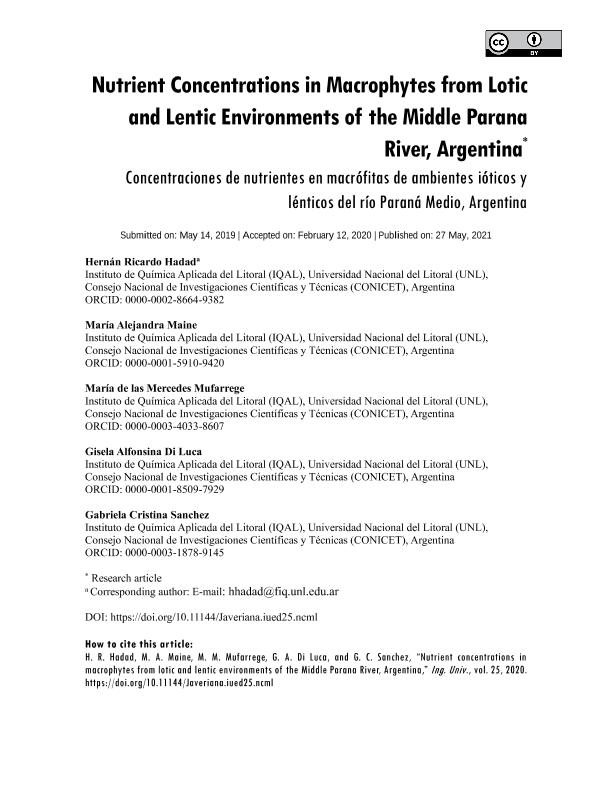Artículo
Objetivos: el objetivo de este trabajo fue comparar las concentraciones de nutrientes en agua, sedimento y en tejidos vegetales de Eichhornia crassipes y Panicum elephantipes estudiadas en ambientes lóticos y lénticos de la llanura aluvial del río Paraná Medio (Argentina). Materiales y Métodos: el estudio tuvo una duración de 18 meses. Plantas, agua y sedimento fueron colectados en una laguna (ambiente léntico) y en un río (ambiente lótico) de la llanura aluvial del río Paraná Medio. Agua y sedimento fueron colectados en sitios dominados por P. elephantipes o E. crassipes, y en sitios sin vegetación. Resultados y Discusión: los ambientes lénticos y lóticos dominados por E. crassipes mostraron las concentraciones de amonio más altas. El sedimento del ambiente lótico mostró concentraciones de fósforo total (PT) y nitrógeno total Kjeldahl (NTK) significativamente menores que las del sedimento del ambiente léntico. En este ambiente, el sedimento de la laguna dominada por E. crassipes mostró la concentración más alta de NTK, mientras que el sedimento de la laguna dominada por P. elephantipes mostró la concentración más alta de PT. Para ambas especies y ambos ambientes, las concentraciones de NTK y PT en tejidos vegetales fueron significativamente mayores en hojas que en raíces. Conclusiones: nuestros resultados podrán ser utilizados para optimizar la eficiencia de humedales de tratamiento. Además, el uso de macrófitas localmente disponibles como bioacumuladoras de contaminantes en la llanura aluvial del río Paraná Medio, es completamente factible. Objectives: The purpose of this work was to compare nutrient concentrations in water, sediment, and in plant tissues of Eichhornia crassipes and Panicum elephantipes from lotic and lentic environments of the Middle Parana River floodplain (Argentina). Materials and Methods: The study was carried out over an 18-month period. Plants, water, and sediment were collected in a lake (lentic environment) and in a river (lotic environment) from the Middle Parana River floodplain. Water and sediment were sampled in sites where P. elephantipes or E. crassipes were predominant and in sites without vegetation. Results and Discussion: The lentic and lotic environments dominated by E. crassipes showed the highest ammonium concentrations. The sediment from the lotic environment showed total phosphorus (TP) and total Kjeldahl nitrogen (TKN) concentrations significantly lower than those found in the sediment from the lentic environment. In the lentic environment, the sediment from the lake with the dominance of E. crassipes showed the highest TKN concentration, while the sediment from the lake dominated by P. elephantipes showed the highest TP concentration. For both plant species and for both environments, TKN and TP tissue concentrations were significantly higher in leaves in comparison with roots. Conclusions: Our results could be used to optimize the efficiency of treatment wetlands. Additionally, the use of locally available macrophytes as contaminant bioaccumulators in the Middle Parana River floodplain is completely feasible.
Nutrient concentrations in macrophytes from lotic and lentic environments of the Middle Parana River, Argentina.
Título:
Concentraciones de nutrientes en macrófitas de ambientes ióticos y lénticos del río Paraná Medio, Argentina
Hadad, Hernán Ricardo ; Maine, Maria Alejandra
; Maine, Maria Alejandra ; Mufarrege, María de Las Mercedes
; Mufarrege, María de Las Mercedes ; Di Luca, Gisela Alfonsina
; Di Luca, Gisela Alfonsina ; Sánchez, Gabriela Cristina
; Sánchez, Gabriela Cristina
 ; Maine, Maria Alejandra
; Maine, Maria Alejandra ; Mufarrege, María de Las Mercedes
; Mufarrege, María de Las Mercedes ; Di Luca, Gisela Alfonsina
; Di Luca, Gisela Alfonsina ; Sánchez, Gabriela Cristina
; Sánchez, Gabriela Cristina
Fecha de publicación:
05/2021
Editorial:
Pontificia Universidad Javeriana
Revista:
Ingeniería y Universidad
ISSN:
0123-2126
e-ISSN:
2011-2769
Idioma:
Inglés
Tipo de recurso:
Artículo publicado
Clasificación temática:
Resumen
Palabras clave:
Wetlands
,
Macrophytes
,
Phosphorus
,
Nitrogen
Archivos asociados
Licencia
Identificadores
Colecciones
Articulos(IQAL)
Articulos de INSTITUTO DE QUIMICA APLICADA DEL LITORAL
Articulos de INSTITUTO DE QUIMICA APLICADA DEL LITORAL
Citación
Hadad, Hernán Ricardo; Maine, Maria Alejandra; Mufarrege, María de Las Mercedes; Di Luca, Gisela Alfonsina; Sánchez, Gabriela Cristina; Nutrient concentrations in macrophytes from lotic and lentic environments of the Middle Parana River, Argentina.; Pontificia Universidad Javeriana; Ingeniería y Universidad; 25; 5-2021; 1-14
Compartir



